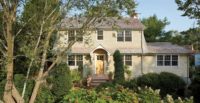Luzern, Switzerland
Architects understandably yearn to be their own clients, especially when it comes to their homes. But Remo Halter of the Luzern, Switzerland, firm, Lussi + Halter, couldn't afford to build his ideal house—a cubic volume of poured-in-place concrete. Yet he had found a tranquil setting—over a third of an acre in the wooded residential district of Kastanienbaum, not far from downtown Luzern. So he and his Brazilian wife, Cristina Casagrande, a psychoanalyst, looked for a “roommate”—that is, someone to share his design for a 6,652-square-foot two-family house divided vertically down the middle.
Halter found adventurous partners for his project: a physician-and-artist couple. “The doctor wanted something new and quite brave,” says Halter about his plan to create an anthracite-hued concrete house. A far cry from the gemütlich gabled houses of the neighborhood, the three-level structure's poured-concrete walls, floors, and piers form a crisp, brooding mass floating above the voids for open-air carports, terraces, and walkways.
The house's impeccable detailing and clarity of form also reveal an affinity to Le Corbusier that both Halter and his partner, Thomas Lussi, acquired during their architectural training at the Eidgenössische Technische Hochschule (ETH) in Zürich. Since 1999, the two have practiced together in Luzern, where they have been winning competitions for schools, housing, and hotels. The firm's Dreilinden School Propsteimatte in Luzern (2005), in which concrete, oak, and daylight animate interior spaces, demonstrates the architects' knowing manipulation of plan and section.
Halter's use of Corbusian language at the Twin Houses brings to mind the master's Museum of Ahmedabad in India (1957) or the Shodan House (1956), also in Ahmedabad, in the way the stalwart block seems to defy gravity. Even the double carports at the front of the Luzern house recall Le Corbusier's vehicular approach to Villa Savoye at Poissy in France (1929).
As you proceed into the vestibule and walk past Casagrande's office, you are pulled toward the forest at the rear of the property, visible through an expansive glass wall. But wait: As you arrive at the kitchen/living/dining area, you behold a Corbusian coup de théâtre. Rather than stairs, attenuated ramps stretch to the lower level and to the second floor along the concrete party wall separating the two residences. The ramps have a gradient similar to the exterior ramp to the roof at Villa Savoye, Halter points out. But unlike Le Corbusier's, Halter's ramps don't have pipe rails—nor a parapet, nor balustrade. No nothing.
When asked about Swiss building codes that allow you to leave out handrails (a sin of omission that American architects may not easily forgive, even for private houses abroad), Halter explains that the municipality only requires the homeowner to sign off on liability claims. Nevertheless, the architect did not inflict his architectural obsessions completely on his neighbor: The doctor opted for wood stairways. Crafted of the same Jatobá (a Brazilian cherry) as Halter's ramps, the stairs next door are quite handsome. But we must confess that the sculptural interplay of the ramps is breathtaking to look at, and literally so to walk up or down.
The ramps underscore the strong processional experience Halter introduced into his house. The one leading upstairs terminates in an enclosed court open to the sky. From there, a concrete stair (no handrails again), like the one Le Corbusier designed for Charles de Bestegui's penthouse garden in Paris (1931), takes the intrepid to a rooftop pool and deck shared by both families. The second interior ramp leads from the main floor down to the basement, which contains additional living and service spaces, not to mention a room for a geothermal pump. “We have no need for oil or gas,” says Halter, who notes that all hot water and heating, including that for the pool, are provided by the geothermal system.
Terraces and covered balconies connect spaces within the self-contained platonic volume to the outdoors. A covered balcony off the master bedroom provides framed views of the forest. In addition, a rear terrace adjoining the living area links to the lawn and woods by a wide cascade of stairs. Covered walkways edge the long elevations and afford protection from the sun via roll-down louvered pine blinds supported on elegantly thin steel columns. To reduce heat loss in the winter months, Halter specified triple-glazing for the inner walls that enclose the house proper.
If Le Corbusier were alive, he might envy the high level of craft now so evident in Swiss construction, particularly that executed in concrete: Le Corbusier's iconic landmarks usually had to be realized with plastered masonry or concrete that spalled. Here Halter can pay homage to the pioneer architect while advancing and refining his vocabulary in new ways and with better technology.
The architect, along with his wife (and visiting children from his first marriage), has found the house to be very comfortable. And, fortunately, his neighbors seem happy with their Modernist home. The mystical color may help. As Halter says, “The black box is powerful. You feel a certain energy emanating from it.”
Completion Date: August 2011
Size: 6,652 square feet
Architect:
Lussi+Halter Partner AG
Dipl. Architekten ETH SIA BSA
Neustadtstrasse 3
CH-6003 Luzern
Switzerland
PeopleOwner: Remo Halter
Architect
Personnel in architect's firm who should receive special credit:
Coordinator architects: Corina Kriener
Interior Designer: Remo Halter
Landscape designer: Koepfli Partner GmbH
Light designer: Remo Halter in cooperation with
Electrics: Jules Häfliger AG
Hydraulic: Markus Stolz
Woods: Vogel Design AG
Structure: Gmeiner AG
Constructor: Schmid Bauunternehmung AG
|
ProductsGlass: Biene Jatobá wood: Schnyder Parkett |
















Post a comment to this article
Report Abusive Comment